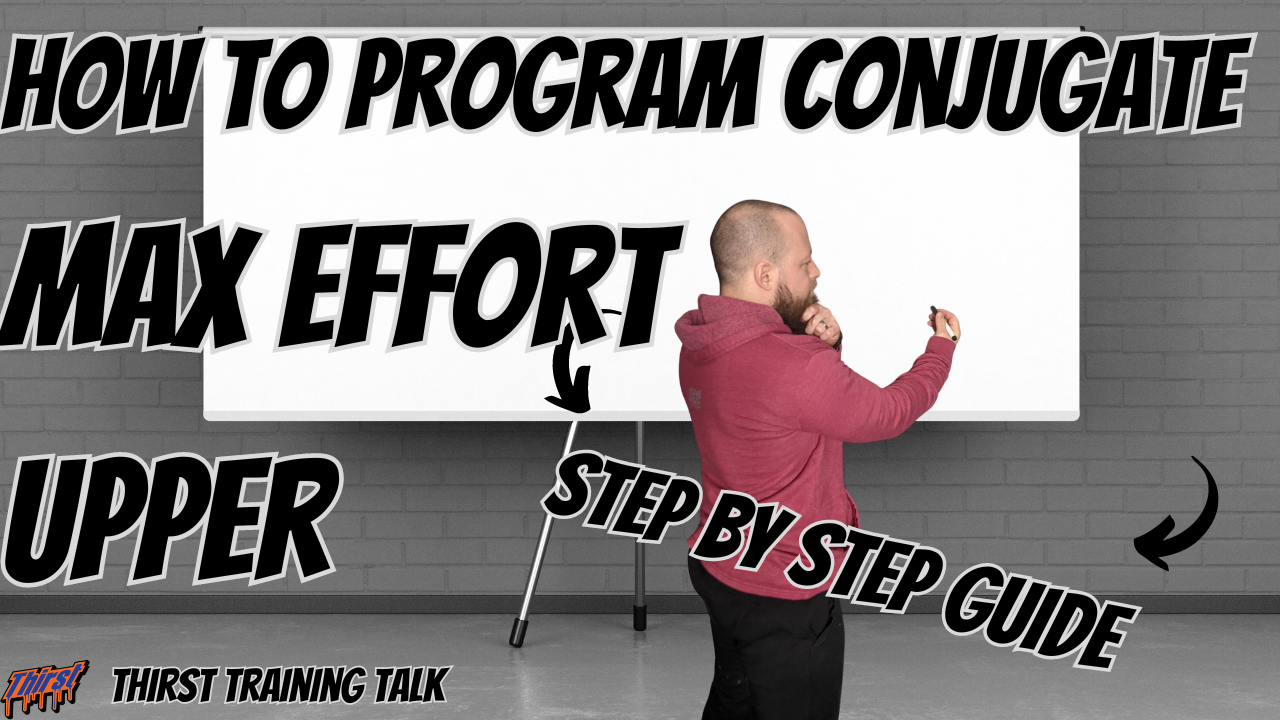Designing Your Conjugate Program: A Complete Guide to Max Effort Upper Body Training
For powerlifters and strength athletes looking to optimize their bench press performance, understanding how to properly structure your max effort upper body training day is crucial. In this comprehensive guide, we’ll break down the conjugate method’s approach to upper body training and provide you with a detailed framework for success.
If you don’t want to read this article, you can watch the video below to gather all the same information.
Understanding the Foundations of Max Effort Upper Training
The primary goal of max effort upper body training in the conjugate system is to improve your one-rep max on the bench press. For the raw lifter, this means focusing on three key areas:
- Triceps development
- Chest (pectoral) strength
- Upper back and lat engagement
- Shoulder stability and strength
Main Movement Selection
The cornerstone of your max effort upper day should be a movement that directly addresses your weaknesses. For lifters struggling with strength off the chest (a common issue), consider these variations:
- Spoto Press
- Larson Press
- Incline Bench
- Floor Press (particularly effective for shorter-armed lifters)
- One-board Press
- Bench Press against bands or chains
Programming Your Main Movement
When structuring your main movement, follow these guidelines:
- Work up to a 1-3 rep max (preferably a 3RM)
- Target around 90-92.5% of your one-rep max
- Aim for an RPE of 9 (one rep left in reserve)
- Include 2-3 back-down sets at RPE 8
- Keep back-down set reps between 2-4
Secondary Movement Selection
Your secondary movement should complement your main movement and address specific weaknesses. For our example focusing on chest-weakness, here’s how to structure it:
- Choose movements like Spoto Press with a 2-count pause
- For size-focused athletes:
- 2-3 sets of 5-8 reps
- RPE 6-8
- For strength-focused athletes:
- Work up to one top set of 3-6 reps
- RPE 7-9
Accessory Work Progression
Heavy Tricep Extensions (C1 Exercise)
Choose from:
- Rolling tricep extensions
- Skull crushers (barbell or dumbbell)
- JM Press
- Neutral grip dumbbell work
- Dips
Programming guidelines:
- 3-4 sets
- 8-12 reps
- Focus on quality movement
Secondary Tricep Work (D1 Exercise)
Options include:
- Press downs
- Overhead extensions
- Dip variations
- Push-ups
- Machine work
For optimal results:
- 2-4 sets
- 10-20 reps
- Maintain technical quality
Finishing Work
High-Rep Tricep Work (E1)
- Band press downs
- Overhead extensions
- Focus on accumulating volume
- Target 15-30 reps or 100 total reps
Upper Back/Shoulder Work (E2)
Choose from:
- Face pulls
- Band pull-aparts
- Lat pulldowns
- Reverse pec deck
- Rear delt raises
Programming Considerations Within Your Training Week
When designing your max effort upper day, consider its placement in your training week:
- Allow 1-2 days between max effort lower and upper days
- Consider the impact on your dynamic effort lower day
- Manage back work volume to prevent interference with deadlift training
- Account for CNS fatigue management
Exercise Selection and Recovery Chain
Your accessory work should “feed up the chain,” meaning each exercise builds upon the others to support your main movement:
- Upper back/tricep work supports heavier tricep work
- Heavier tricep work supports pressing variations
- Pressing variations support main movement
- Main movement improves competition bench press
Advanced Modifications
For those needing additional shoulder or chest work:
- Replace some tricep volume with direct shoulder work
- Add delt work to dynamic effort upper day
- Incorporate pec-specific movements like dumbbell flyes
- Consider adding deficit push-ups for chest development
Key Takeaways
- Focus on addressing weaknesses through main movement selection
- Maintain appropriate volume and intensity relationships
- Consider the impact of exercise selection on other training days
- Progress exercises in a logical sequence
- Adjust accessory work based on individual needs
By following these guidelines and maintaining consistency in your training, you’ll be well on your way to developing a stronger bench press through the conjugate method.
Looking to learn more about conjugate training? Apply to work with me one-on-one or join my conjugate training for raw powerlifting on TrainHeroic!








